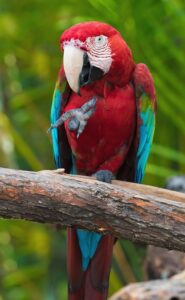
Birds have long been cherished as companions, offering a unique blend of beauty, intelligence, and companionship. Their vibrant personalities and ability to form strong bonds with humans make them excellent pets. However, unlocking the full potential of bird companionship requires understanding and meeting their essential needs. This article delves into the key aspects of caring for companion birds, ensuring they thrive in a domestic environment.
Understanding Bird Psychology
Before delving into the tangible needs of companion birds, it’s crucial to understand their psychology. Birds are intelligent creatures with complex social structures and behaviors. Understanding their natural instincts and behaviors is the first step towards building a strong bond.
Social Creatures
Most pet birds, such as parrots, cockatiels, and lovebirds, are inherently social animals. In the wild, they live in flocks and rely on social interactions for survival and mental stimulation. In captivity, these social needs must be met through interaction with their human companions or other birds.
Intelligence and Curiosity
Birds are highly intelligent and curious creatures. They require mental stimulation to prevent boredom and the development of negative behaviors, such as feather plucking or excessive vocalization. Enrichment activities and environmental enhancements are essential to cater to their intellectual needs.
Creating a Safe and Stimulating Environment
The environment in which a bird lives plays a critical role in its overall well-being. Providing a safe and stimulating habitat is essential for their physical and mental health.
Appropriate Housing
The cage or aviary is the primary living space for a pet bird. It should be spacious enough to allow the bird to move freely and comfortably. The cage must be equipped with perches, toys, and feeding stations. The size of the cage should be proportionate to the bird’s size and activity level. For larger birds, aviaries or flight cages are ideal.
Safety Considerations
Ensuring the bird’s safety is paramount. The living environment should be free of hazards such as toxic plants, open windows, and other pets that may pose a threat. Regularly inspect the cage and toys for wear and tear that could pose a danger.
Environmental Enrichment
Providing environmental enrichment is crucial for preventing boredom and promoting natural behaviors. This can include a variety of toys, puzzles, and foraging activities. Rotating toys and introducing new challenges regularly can keep the bird mentally and physically active.
Nutrition and Dietary Needs
A balanced diet is fundamental to a bird’s health and longevity. Understanding and providing the right nutrition ensures they receive the necessary nutrients to thrive.
Species-Specific Diets
Different bird species have varying nutritional requirements. Parrots, for example, benefit from a diet rich in fruits, vegetables, seeds, and pellets. Researching the specific dietary needs of your bird species is essential.
Fresh Foods and Pellets
Incorporating fresh fruits and vegetables into a bird’s diet provides essential vitamins and minerals. Pellets are also an excellent source of balanced nutrition, but they should not be the sole component. A mix of fresh foods and high-quality pellets is ideal.
Avoiding Harmful Foods
Some foods are toxic to birds, such as avocado, chocolate, caffeine, and alcohol. It’s crucial to educate yourself on harmful foods and ensure they are kept out of reach.
Health Care and Regular Check-Ups
Regular health care is vital for maintaining a bird’s well-being. This includes routine veterinary check-ups and monitoring for signs of illness or distress.
Finding an Avian Veterinarian
Establishing a relationship with an avian veterinarian is crucial. Birds have unique health needs that require specialized knowledge. Regular check-ups can help detect potential health issues early.
Signs of Illness
Being vigilant about your bird’s health is essential. Common signs of illness include changes in appetite, feather condition, droppings, and behavior. Early detection and treatment can prevent minor issues from becoming serious health problems.
Social Interaction and Training
Building a strong bond with a bird involves social interaction and training. This not only enhances the companionship experience but also contributes to the bird’s mental well-being.
Quality Time
Spending quality time with your bird is essential. This includes talking to them, playing games, and allowing them to perch on your hand or shoulder. Consistent interaction helps build trust and strengthens the bond.
Training and Communication
Birds can be trained to perform various tricks and behaviors. Positive reinforcement techniques, such as treats and praise, are effective in training. Training sessions should be short, fun, and consistent to maintain the bird’s interest.
Understanding Body Language
Birds communicate through body language. Understanding their cues, such as the position of their feathers, eyes, and posture, can provide insight into their mood and needs. This understanding fosters better communication and a stronger bond.
Conclusion
Unlocking the full potential of bird companionship requires a commitment to meeting their essential needs. By understanding their psychology, providing a safe and stimulating environment, ensuring proper nutrition and health care, and engaging in social interaction and training, you can create a thriving relationship with your feathered friend. Birds are not just pets; they are companions that enrich our lives with their vibrant personalities and unwavering loyalty. With the right care, they can provide years of joy and companionship.
#ChatGPT assisted in the creation of this article.








